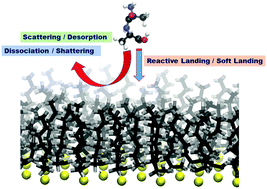Chemical dynamics simulations of energy transfer, surface-induced dissociation, soft-landing, and reactive-landing in collisions of protonated peptide ions with organic surfaces
Abstract
There are two components to the review presented here regarding simulations of collisions of protonated peptide ions peptide-H+ with organic surfaces. One is a detailed description of the classical trajectory chemical dynamics simulation methodology. Different simulation approaches are used, and identified as MM, QM + MM, and QM/MM dependent on the potential energy surface used to represent the peptide-H+ + surface collision. The second are representative examples of the information that may be obtained from the simulations regarding energy transfer and peptide-H+ surface-induced dissociation, soft-landing, and reactive-landing for the peptide-H+ + surface collisions. Good agreement with experiment is obtained for each of these four collision properties. The simulations provide atomistic interpretations of the peptide-H+ + surface collision dynamics.

- This article is part of the themed collection: Surface Reaction Dynamics

 Please wait while we load your content...
Please wait while we load your content...